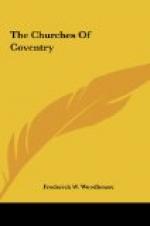LIST OF ILLUSTRATIONS:
Coventry, the three spires
Arms of the town
View from the top of bishop street
Cook street gate
Seal of the priory
West end of the priory church
Remains of the north-west tower in the eighteenth century
St. Michael’s from the north
St. Michael’s from the north-west
Interior of the tower from below
The west porch
South porch from st. Mary hall
South-west doorway
Interior of st. Michael’s from the west
Tower arch
Bay of nave, north side
Interior from the south door
The choir from st. Lawrence’s chapel
Poppy head, lady chapel
Miserere, lady chapel
Chest in north aisle
The Nethermyl tomb
The Swillington tomb
Alms-Box
Holy Trinity from the north (about 1850)
Plan of Trinity church
Interior of holy Trinity, from the west
North side of nave-eastern bays
Pulpit
Archway between the north porch and st. Thomas’s chapel
Alms-Box
Church of st. John Baptist
Plan
Interior
Clearstory windows
The spire of Christ church
Grey friars’ church (plan of crossing)
St. Mary hall
Plan
Plan of st. Michael’s church
[Illustration: View from the top of bishop street.]
CHURCHES OF COVENTRY
MONASTERY AND CITY
The opening words of Sir William Dugdale’s account of Coventry assert that it is a city “remarkable for antiquity, charters, rights and privileges, and favours shown by monarchs.” Though this handbook is primarily concerned with a feature of the city he does not here mention—its magnificent buildings—the history of these is bound up with that of the city. The connection of its great parish churches with the everyday life of the people, though commonly on a narrower stage, is more intimate than is that of a cathedral or an abbey church, but it is to be remembered that without its Monastery Coventry might never have been more than a village or small market town.
We cannot expect the records of a parish church to be as full and complete as those of a cathedral, always in touch through its bishops with the political life of the country and enjoying the services of numerous officials; or as those of a monastery, with its leisured chroniclers ever patiently recording the annals of their house, the doings of its abbots, the dealings of their house with mother church and the outside world, and all its internal life and affairs.




